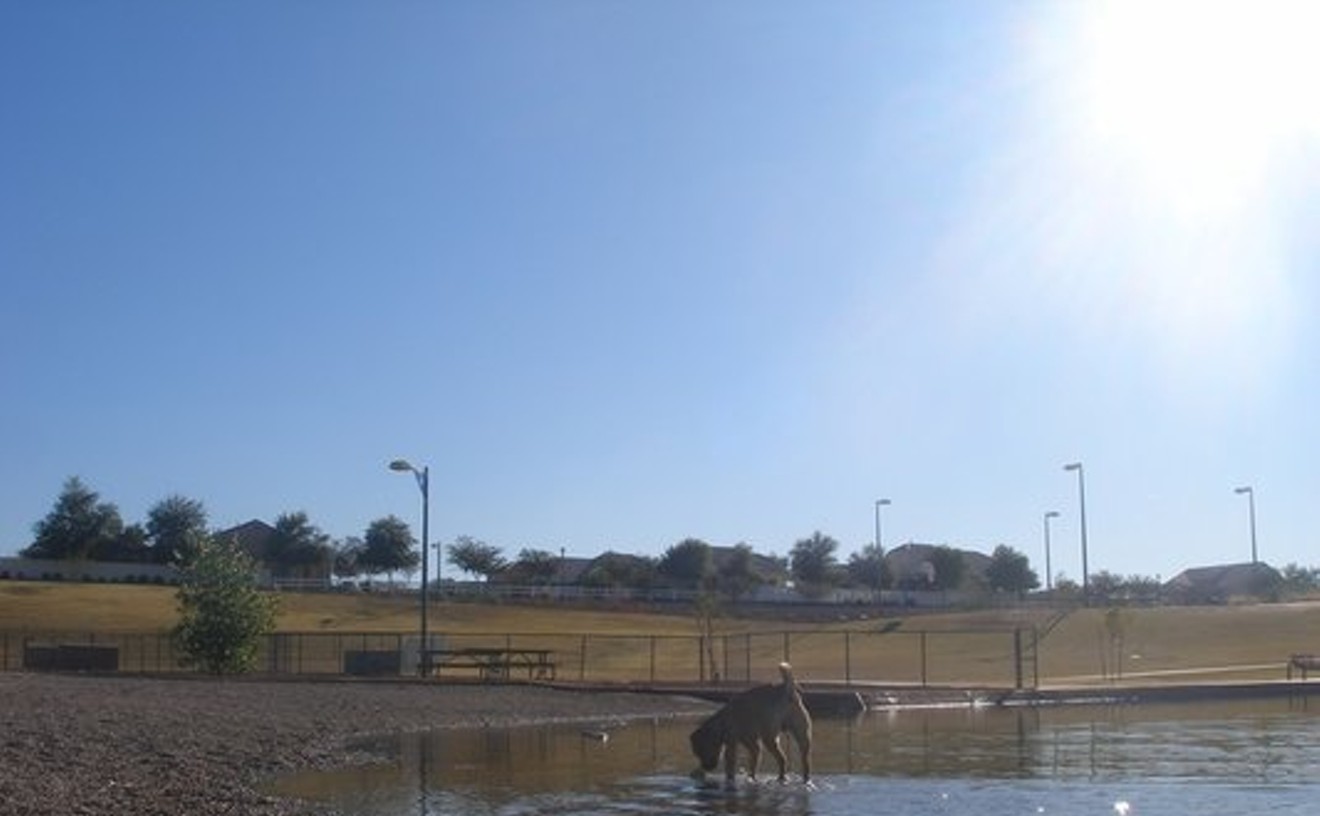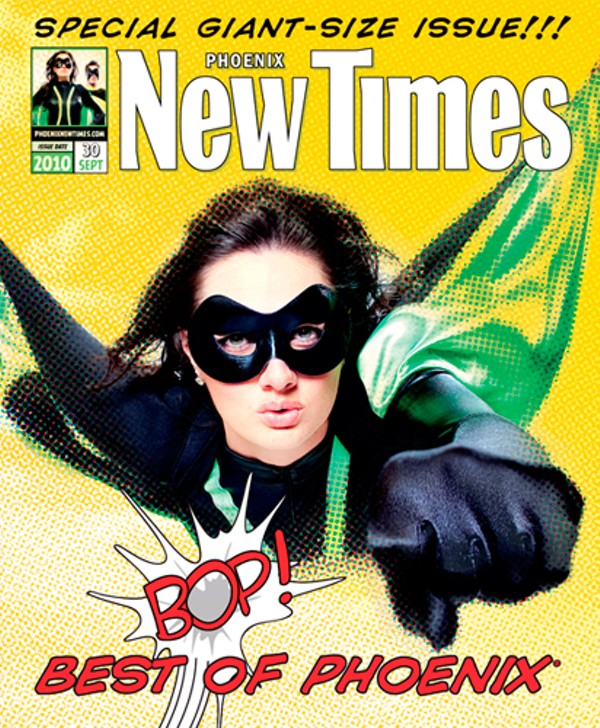Best Adventure Hike
Four Peaks after a snowstorm
Hiking to the top of Brown's Peak, the tallest summit of Four Peaks, can be a challenge for people in the best conditions. Brown's Trail, the typical summit route, is about four miles round-trip and steep in places. Hands-on scrambling is required near the top of the gully close to the summit. After a wet year, like this one, the upper flanks of Four Peaks can be covered with ice and snow. And that changes things for hikers — for the better, if you like adventure. When we hiked Four Peaks with a friend in mid-April, the gully was a long, glacier-like ice chute. The only group of hikers we saw summiting that day, besides us, had used harnesses and a climbing rope to belay each other up. Somewhat unintelligently, we forged our way up the chute using sticks like half-assed ice axes. Wearing crampons, those spikes you can attach to your shoes, would have been preferable for the hike. While crossing the chute seemed to invite a potential death fall, the sketchiest moment of the hike came when hikers above us kicked down a head-size boulder. The boulder rolled down the snowfield straight for us and banged into the stick we were holding. We descended a different way, spidering over the snowless summit blocks, ending up in thigh-high snow before finding the main trail. In other words, this spring outing felt like a day in the Himalayas. We're going back the next time it snows — and we'll be taking better gear.
Best Night Hike
South Mountain Pima Canyon
At 7 p.m., the gate closes off the park road leading into Pima Canyon, near the northeast tip of Phoenix's extraordinary South Mountain Park/Preserve. Cars can't get back in there — but you can. A ranger told us recently that night hikers or bikers are good to go, even after hours. (He added that if police catch you out there past 11 p.m., they may tell you to get out but won't ticket you). We can't tell you where to park for a night adventure in South Mountain — the Pointe neighborhood surrounding the park entrance is private property. However, once there, it's a beautiful, peaceful walk by moonlight — or starlight — that anyone can do. Unlike a desert single-track trail, this hike is easy at night because it begins on a mile-long asphalt road (usually filled with parked cars in the daytime) and continues with another mile or so of pleasant dirt road winding through low hills. At night, we typically stop at the benches near the National Trail trailhead before turning around. True, the place can be spooky after the sun goes down — akin to a stroll down a long, dark alley. It's probably best to take a friend or two. But if you're the type who scoffs at such risk, hiking Pima Canyon at night offers a tantalizing trade of perfect safety for an hour or two of wilderness-inspired bliss. Did we mention it's cooler at night?
Best Grand Canyon Training Hike
Phoenix Mountains Recreation Area/Piestewa Peak
We've hiked the Grand Canyon to the Colorado River and back up in a day many times, and only once did the climb out nearly do us in. On that fateful trip, somewhere between Indian Gardens and the three-mile rest stop on the Bright Angel trail, as our quads seemed ready to pull off the bone, we vowed never again to forgo our traditional Grand Canyon training hike. Our friend came up with this one: You hike to the top of Piestewa Peak via the main summit trail, but instead of going all the way back down, you set off on the four-mile Circumference Trail. That will plug you back to the lower slopes of Piestewa and the main summit trail — which you then climb to the top. Although our buddy claims the second time up is easier, because you're warmed up, we've never found that to be the case — it always seems much tougher. But adding this hike to your training regimen will allow you to enjoy the Grand Canyon ambiance instead of worrying whether you'll need a mule to drag you out.
Best Wildflower Hike
Usery Mountain Regional Park, Pass Mountain Loop
This may be our all-time favorite hike in the Valley. If you want to see the Sonoran Desert in its entire splendor, head to Usery and rock the Pass Mountain Loop hike. Just make sure it's between February and May when our unique vegetation actually looks fertile (for once). Yes, the saguaros will be tipped with white blossoms; the ocotillo will be covered in lush leaves and orange blooms; and the barrel cacti will glow with their hot pink, orange, and yellow flowers. And don't forget the Brittle Bush, and, ahem, Blue Dick that sprout from the dirt. We say, with such a rare opportunity to see some life in our desert, make the most of it with this eight-mile loop. You'll certainly get an eyeful as you wrap around the mountain's base, slowly climbing to make a steep descent on the other side.
Best Petroglyph Hike
Kiwanis Trail, South Mountain
For this award, we're not talking about a petroglyph "hike" that barely tips the quarter-mile mark. In our book, walking a few hundred feet in dirt just doesn't count. So when we trekked the two-mile Kiwanis Trail in South Mountain, we not only felt like justified hikers, we got to spy some sweet petroglyphs along the way. The trail runs through Snake Canyon and offers lush vegetation, a peaceful wash, and virtually no traffic; unlike Piestewa or Camelback, this trail hasn't grabbed the attention of the masses. The steady incline makes for an easy cardio workout and, just as you're ready to catch your breath, you may see an ancient spiral rock etching beyond the trail. The markings are left over from our beloved Hohokam Indians, and it's believed that the trail was used as a trade route. Who would have thought that history and exercise could make such a lovely pair?
Best Wheelchair Hike
West Park Accessible Trail at Papago Park

Peter++Scanlon
Attorney+Grady+Gammage+Jr.+%28inset%29+hosted+a+meeting+on+developing+Papago+Park+%28above%29.
Grandpa is pushing 90, and he's on the way out. A couple strokes down, he's still got enough fire to get out of bed and into a wheelchair (but that's about it). Snap out of your denial and take the old soul out for a stroll in our beautiful desert on the Accessible Trail at Papago Park. This paved path stretches for 1.2 miles, but if the old-timer ain't up to the whole thing, a quick turnaround is always an option. This "hike" is relatively flat, with a few gentle slopes and zero climbing. Still, it offers some nice views of the local rock formations and surrounding desert sprawl that can be seen from any height — wheelchair or standing. The trail is plenty wide for a large group of folks, and last time we were there, representatives from all three generations of our family went along for the stroll.
- 625 N. Galvin Parkway, Phoenix, 85004 Map
- 602-256-3220
- www.phoenix.gov/parks/hikepapa.html
Best Dog Hike
Shaw Butte, Trail 306
Sure, walks around the block get the pup to stop being such a spaz (and keep the little guy from doggy obesity), but, just like humans, sometimes canines need a little change of scenery. We recommend Shaw Butte for your dog's next outdoor adventure. Heading west from the trailhead, take trail 306. The uphill trek starts off with a wide dirt service road that climbs a steady incline to reach the Butte's cluster of metal towers. It's a sturdy 1.5-mile hike for Fifi or Fido. From the top, feel free to turn back and cruise downhill. Or push yourself and your companion to make the descent on the other side of the mountain to complete a four-mile loop. Be warned: this part can get a little rocky (we saw a dog with hiking booties on its paws one day — no joke). Either way, we've spied plenty of pooches on this trail, and those four-legged energy machines looked like they were loving every second.
Best Dog Park, West Valley
PetSmart Dog Park at Washington Park

We know too many parks in the Valley where dog owners take over, allowing their antsy and often-aggressive canines to run free and trample (sometimes literally) the rights of all others. Time and again, we have fantasized about "rescuing" some feral pit bulls from south of the border and setting them loose in said parks as we announce to the other dog owners, "Oh, don't worry. They're really friendly." We are heartened by this expansive, fenced-in facility (with little dogs on one side separated from the bigger dogs on the other) just north of the tennis center south of Glendale Avenue. Sure, it gets crowded on occasion with both dogs and masters, but everyone seems adult about how to negotiate — none of that sense of entitlement to let their animals do what they want and damn the rest of the world. Just recently, we saw a Jack Russell terrier cozy up to a mini-daschund in a corner and make friends. Before you knew it, a couple of nosy beagles cozied up to the pair and a coffee klatch (minus the joe) ensued. It was a Kumbaya moment that brought a smile to our faces.
- 6655 N. 23rd Ave., Phoenix, 85015 Map
- 602-262-6575
Best Dog Park, East Valley
Cosmo Dog Park

It doesn't take a whole lot to please a dog — a field and a ball will often do the trick — but the city of Gilbert is home to a park for pooches so impressive that even humans have taken notice. Cosmo Dog Park is widely regarded as the best dog park in the East Valley and was even nationally recognized in June by Dog Fancy Magazine as the fourth-best dog park in the country. The four-acre park welcomes all types of dogs — even the most anti-social hounds can unwind in the park's fenced-off section, for timid pooches. And, of course, there's the lake, complete with a fountain and dock for any pup ready to test his sea legs.
- 2502 E. Ray Rd., Gilbert, 85233 Map
- 480-503-6200
- www.gilbertaz.gov/parks/popups/cosmo-park.cfm
Best Outdoor Playground
Hudson Park
This three-acre neighborhood park has it all: basketball courts, sand volleyball pit, grassy open spaces, a hippie labyrinth complete with a Dalai Lama quotation set in one of many tile mosaics, an adorable skate park with its own half-pipe, and the most wholesome people-watching this side of Mill Avenue (which isn't far, in case you have a hankering for some Mojo fro-yo). The park itself is a playground for all ages, but tucked in its southeast corner is a thoughtfully appointed and newly renovated sensory playground. Old-school swings, slides, ride-ons, and climbing/hanging contraptions balance out the giant bongo and percussion section, meandering paths, shade structures, rock walls, and mini-Mt. Hudson. There's even disability-friendly equipment and a splash area. Gandhi did say that to teach peace, we must begin with the ankle-biters. Playgroup/drum circle, anyone?





